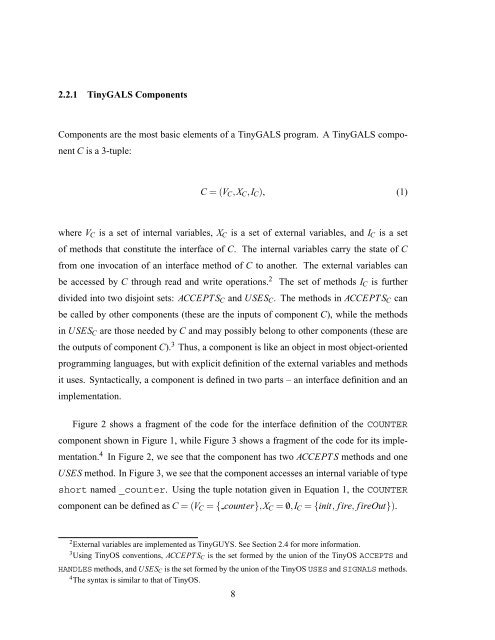Design and Implementation of TinyGALS: A Programming Model for ...
Design and Implementation of TinyGALS: A Programming Model for ...
Design and Implementation of TinyGALS: A Programming Model for ...
You also want an ePaper? Increase the reach of your titles
YUMPU automatically turns print PDFs into web optimized ePapers that Google loves.
2.2.1 <strong>TinyGALS</strong> Components<br />
Components are the most basic elements <strong>of</strong> a <strong>TinyGALS</strong> program. A <strong>TinyGALS</strong> compo-<br />
nent C is a 3-tuple:<br />
C = (VC,XC,IC), (1)<br />
where VC is a set <strong>of</strong> internal variables, XC is a set <strong>of</strong> external variables, <strong>and</strong> IC is a set<br />
<strong>of</strong> methods that constitute the interface <strong>of</strong> C. The internal variables carry the state <strong>of</strong> C<br />
from one invocation <strong>of</strong> an interface method <strong>of</strong> C to another. The external variables can<br />
be accessed by C through read <strong>and</strong> write operations. 2 The set <strong>of</strong> methods IC is further<br />
divided into two disjoint sets: ACCEPT SC <strong>and</strong> USESC. The methods in ACCEPT SC can<br />
be called by other components (these are the inputs <strong>of</strong> component C), while the methods<br />
in USESC are those needed by C <strong>and</strong> may possibly belong to other components (these are<br />
the outputs <strong>of</strong> component C). 3 Thus, a component is like an object in most object-oriented<br />
programming languages, but with explicit definition <strong>of</strong> the external variables <strong>and</strong> methods<br />
it uses. Syntactically, a component is defined in two parts – an interface definition <strong>and</strong> an<br />
implementation.<br />
Figure 2 shows a fragment <strong>of</strong> the code <strong>for</strong> the interface definition <strong>of</strong> the COUNTER<br />
component shown in Figure 1, while Figure 3 shows a fragment <strong>of</strong> the code <strong>for</strong> its imple-<br />
mentation. 4 In Figure 2, we see that the component has two ACCEPT S methods <strong>and</strong> one<br />
USES method. In Figure 3, we see that the component accesses an internal variable <strong>of</strong> type<br />
short named _counter. Using the tuple notation given in Equation 1, the COUNTER<br />
component can be defined as C = (VC = { counter},XC = /0,IC = {init, f ire, f ireOut}).<br />
2 External variables are implemented as TinyGUYS. See Section 2.4 <strong>for</strong> more in<strong>for</strong>mation.<br />
3 Using TinyOS conventions, ACCEPT SC is the set <strong>for</strong>med by the union <strong>of</strong> the TinyOS ACCEPTS <strong>and</strong><br />
HANDLES methods, <strong>and</strong> USESC is the set <strong>for</strong>med by the union <strong>of</strong> the TinyOS USES <strong>and</strong> SIGNALS methods.<br />
4 The syntax is similar to that <strong>of</strong> TinyOS.<br />
8
















